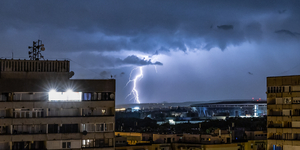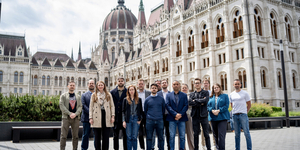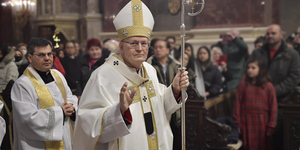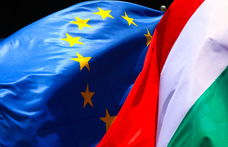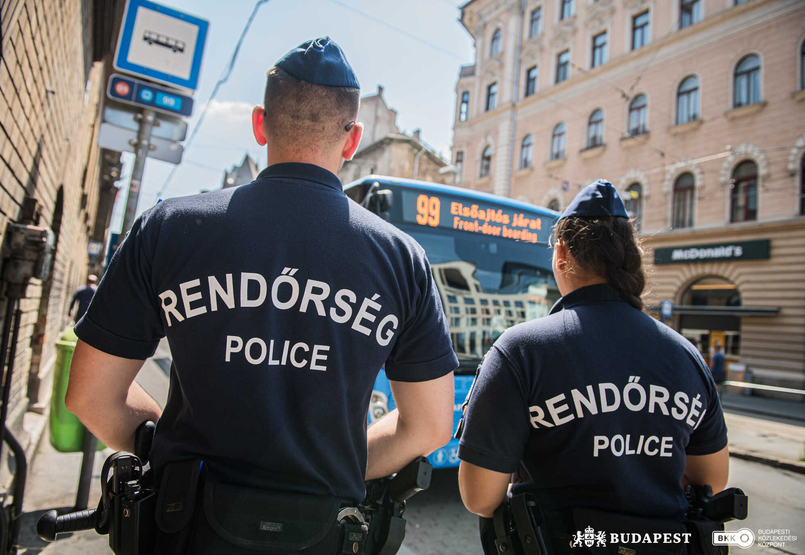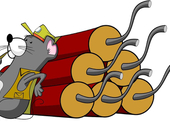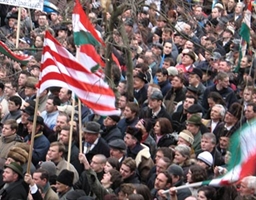 Arpad Flag |
In the 1990s, the red flag of Albert Szabo's World-nation Party for People's Rule contained a black swastika in a white circle at its centre. It was clear that this group of a few dozen people, financed from murky sources, which paraded in uniform with black armbands, wanted to reflect the National Socialist movement, and more precisely the SA. It was formed to shock Hungarian anti-fascists, to scandalise adherents of the Democratic Charter. But Albert Szabo vanished suddenly after 1998, along with his movement and its provocative flag. One reason for this was that the Hungarian extreme right was very suspicious of the movement. Istvan Csurka openly slammed it as an exercise in provocation.
The Hungarian far right did not need the symbols of the German Nazis. It could build on its own traditions. Today, it relies on the neo-arrow cross symbology, built around the Arpad Flag. Hungarist (or Arrow Cross) parties have all tried to emphasise the Arpad Flag on their armbands. Instead of the eight bands of red and silver characteristic of the arms of Hungary, they use nine bands - five red and four white - on their banners, placing a green Arrow Cross in the white quadrant. This reflects, but takes further, the arms of the Middle Ages. The new, nine-banded flag symbolises the five social groups that build up their reawakened Hungary - the peasant, who upholds the nation, the worker, who builds the nation, the intellectuals, who lead the nation, and women, children and the young, who sustain the nation. These groups are held together by Hungarism's moral (Christian), spiritual (nationalistic) and material (Socialist) foundations, along with "co-nationalism," and so the four white bands symbolise the Hungarian nation and the Great Homeland of the Carpathians and the Danube (which includes Hungarians, Slovaks, Ruthenes, Romanians, Germas and Serbs).
However confused and compromised the Arpad Flag's intellectual content, the 300,000 MIEP and Jobbik voters started using it for a very concrete reason. When Feren Szalasi, the "leader of the nation" managed on 15 October 1944 "to take power", the neo-pagan, anti-semitic and radical nationalist ideals that fed his party had a decades long history behind them. Dilletante ideologues and historians had worked hard on this ideology, including Father Zadravetz and Odon Malnasi, whose ideas were popularised by talented journalists like Istvan Milotay and Gyorgy Olah. It is characteristic that an imagined Sumerian-Hungarian relationship and an appropriation of the gospels allowed Arrow Cross mythology to live on after 1945, even in emigration. Ferenc Badinyi Jos, whose works are still cited by believers, died very recently.
The Arpad Flag continues to inspire the nationalist, anti-Semitic Right because it is built on national symbols of the Middle Ages. It provokes the Left and those of Jewish descent by evoking the Holocaust, but it does this without clashing with the law that bans the Arrow Cross as a "symbol of totalitarianism." Clearly, nobody would be bothered by a flag that was purely a historical relic - especially since it appears on the left hand side of the national arms. But just think: elements of the arms of Hungary have been used by other national fascisms. Slovakia's Hlinka Guard marched under a red flag with a dual black cross. This didn't stop the independent Slovak state that came into being in 1993 from placing it atop the new country's coat of arms.
It is striking that Croatia's arms, which were used by the Ustase between 1941 and 1945, also contain symbols that point to the Personal Union of kingdoms. The chequered field of red and white at the centre of the arms are referred to as the chessboard. The 13 red and 12 white fields were used as the symbol of the Croatian kings as early as the 10th century. The colours supposedly symbolise the two ancient Croatian tribes - the Red Croatians and the White Croatians. But this is just a legend, as is the story that the chessboard symbolises Svetoslav Surinj's defeat of the Doge of Venice, Peter Orseolo II in a game of chess, thereby winning suzerainty over the cities of Dalmatia. Croatians argued for a long time over the colour of the first square on the chess board. Some said it should start with a white square, and that starting with a red square would be a disgraceful forgery, since a red square would symbolise the days when Croatia was ruled by other nations. But others said the white square would evoke the pro-Nazi ustasa government, making it a totalitarian symbol.
For the Arpad Flag to regain its true role as a national relic, both political camps will have to make a gesture. The Left likes to accuse Fidesz and its allies of misappropriating all national feeling. They should stop making these allegations. It is enough to think back to the 2002 elections, when it was clear that right-wing voters' weeks-long, demonstrative wearing of the national rosette was counterproductive, since it frightened away moderate centrist voters. The moderate right should simply ask Arpad Flag-bearers to keep away from their rallies. It is striking that this happened at Fidesz's 15 March rally. The compere asked the audience to confine themselves to holding the national flag aloft. But the Left must stop provoking hysterical reactions to all these symbols. They should accept national symbols, even those with baggage, just as happened with the national coat of arms at the time of the Antall government.
János Pelle


